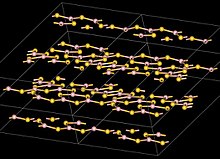This is an old revision of this page, as edited by Anoop.m (talk | contribs) at 11:09, 28 February 2010. The present address (URL) is a permanent link to this revision, which may differ significantly from the current revision.
Revision as of 11:09, 28 February 2010 by Anoop.m (talk | contribs)(diff) ← Previous revision | Latest revision (diff) | Newer revision → (diff) | |
| Names | |
|---|---|
| IUPAC name Boron sulfide | |
| Other names Boron trisulfide | |
| Identifiers | |
| CAS Number | |
| ECHA InfoCard | 100.031.355 |
| CompTox Dashboard (EPA) | |
| Properties | |
| Chemical formula | B2S3 |
| Molar mass | 117.80 g/mol |
| Appearance | colorless crystals |
| Density | 1.55 g/cm, solid |
| Melting point | 563 °C |
| Boiling point | decomposes at high T |
| Solubility in water | decomposes |
| Structure | |
| Crystal structure | monoclinic, mP40, SpaceGroup = P21/c, No. 14 |
| Coordination geometry | B: planar, sp |
| Hazards | |
| Occupational safety and health (OHS/OSH): | |
| Main hazards | source of H2S |
| Related compounds | |
| Except where otherwise noted, data are given for materials in their standard state (at 25 °C , 100 kPa). Infobox references | |
Boron sulfide is the chemical compound with the formula B2S3. This polymeric material that has been of interest as a component of “high-tech” glasses and as a reagent for preparing organosulfur compounds. Like the sulfides of silicon and phosphorus, B2S3 reacts with water, including atmospheric moisture to release H2S. Thus, samples must be handled under anhydrous conditions.
Like the boron oxides, B2S3 readily forms glasses when blended with other sulfides such as P4S10. Such glasses absorb lower frequencies of Infra-red energy relative to conventional borosilicate glasses.
B2S3 converts ketones into the corresponding thiones. For example, the conversion of benzophenone to its thione proceeds as follows:
- B
2S
3 + 3 (C
6H
5)
2C=O → B
2O
3 + 3 (C
6H
5)
2C=S
In practice, B2S3 would be used in excess.
Synthesis
Besides other methods the boron sulfide can be obtained by the reaction of iron or manganese boride with hydrogen sulfide at temperatures of 300°C.
- 2 FeB + 4 H2S → B2S3 + FeS + 4 H2
The first synthesis was done by Jöns Jakob Berzelius in 1824 by direct reaction of amorphous boron with sulfur vapor.
- 2 B + 3 S → B2S3
Another synthesis was favoured by Friedrich Wöhler and Henri Etienne Sainte-Claire Deville first published in 1858, starting from boron and hydrogen sulfide.
- 2 B + 3 H2S → B2S3 + 3 H2
References
- Sato, R. (2004). "Boron trisulfide". In L. Paquette (ed.). Encyclopedia of Reagents for Organic Synthesis. New York.: J. Wiley & Sons. doi:10.1002/047084289.
- J. Hoffmann (1908). "Synthese von Borsulfid aus Ferro- und Manganbor". Zeitschrift für anorganische Chemie. 59 (1): 127–135. doi:10.1002/zaac.19080590116.
- F. Wöhler and H. E. S.-C. Deville (1858). "Neue Beobachtungen über das Bor und einige seiner Verbindungen". Liebigs Annalen. 105 (1): 67–73. doi:10.1002/jlac.18581050109.
- F. Wöhler and H. E. S.-C. Deville (1858). "Du Bore". Annales de chimie et de physique. 52: 62–93.
| Boron compounds | |
|---|---|
| Boron pnictogenides | |
| Boron halides | |
| Acids | |
| Boranes | |
| Boron oxides and sulfides | |
| Carbides | |
| Organoboron compounds | |